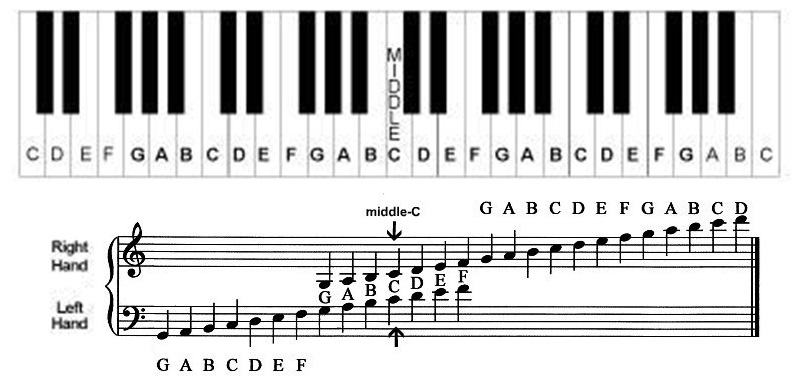
Grand Staff Notes Explained: Learn how to read the notes on the Staves.
What are Staff Lines?
Pick up any piece of written music and you can see groups of lines on which music note symbols are written. In standard Western musical notation, this group of lines (on which the music notes are drawn) is known as the Staff or Stave!
This set of five horizontal lines and four spaces (staff lines) is where the music notes are drawn. The various note symbols that are placed on these lines & spaces indicate the pitch of the notes on staff.
A Staff basically consists of five lines and four spaces. Notes drawn on the lines or spaces on a staff will correspond to white keys on the keyboard.

What are Clefs?
A Clef is basically a symbol which you assign to a Staff, right at the beginning. When you assign a Clef to a staff, specific notes get assigned to the lines and spaces. The two Clefs that are commonly used are the Treble clef and the Bass clef.

The moment you place a symbol called Clef on the left hand side of the staff, the notes on staff will have a fixed pitch assigned to them. Read more about Treble Clef and Bass Clef on the piano lesson pages!
The music notes on staff should be read from left to the right i.e. one after the other. The time signature, tempo of the piece, and the duration of the notes on staff will determine how fast/slow the staff notes need to be played.
What are Ledger Lines?
Ok! So now you know about the treble and the bass clefs. But what if any song needs higher notes that cannot be fit within the five lines of the treble clef…or if the song needs lower notes in the bass clef that cannot be fit within its five lines? The solution is to use Ledger Lines, which are small lines that you put on top of the treble clef or at the bottom of the bass clef when your song needs more space for its notes.
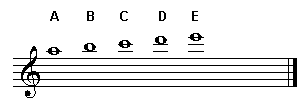
A ledger line is a musical notation which looks like a small horizontal line. Ledger lines are used to write musical notes that cannot be fitted within the lines and spaces of regular musical staffs.
Ledger lines are small lines that you put on top of the treble clef or at the bottom of the bass clef when your song needs more space for its notes.
You can have as many ledger lines as you need but having too many ledger lines above or below the staffs makes it difficult to read the notes.
When the musical notes are going to be too high, requiring many ledger lines, a better option is to use the 8va notation to depict the notes instead of the ledger lines.
Grand Staff
When you join two staves (usually the Treble & Bass Clefs) by a brace, suggesting that the notes on them needs to be played at once by a single performer, a Grand Staff is formed. In this instance, middle C is centered between the two staves.
The Grand staff is nothing but a theoretical staff showing both the treble and the bass clef together, the treble on the top and bass in the bottom. The major advantage of using a grand staff for writing music is that you can show nearly all musical notes there without having to use many ledger lines or octave shifts.
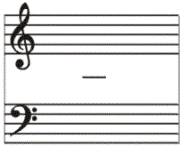
The line in the middle of the two clefs is known as the middle C. It is known as the middle C just because it appears between the two clefs. Please note that on an actual keyboard/piano it corresponds to a key which is not physically in the middle of the instrument.
Treble Clef Notes
The Treble clef is where you have your higher pitched notes. Most of the time they tend to be the melody notes and you have to play them with your right hand.
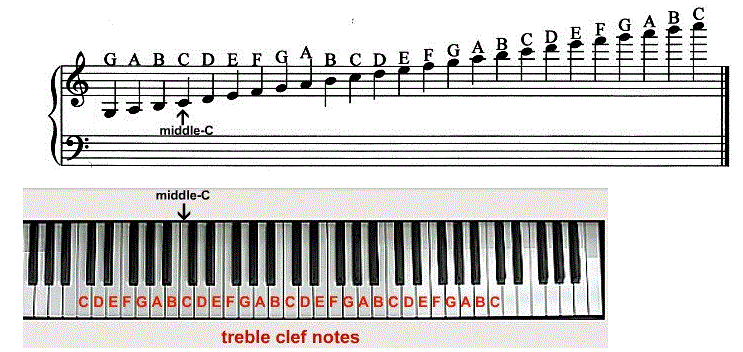
Some more information on this clef:
The Treble Clef is also known as the G Clef. This is because the clef wraps the second line from the bottom. Any note on this line is the G note.
Notes on the Lines – E G B D F.
Beginning from the bottom, the first line is for E and the fifth line is for F
Notes on the Spaces – F A C E.
Beginning from the bottom, the first space is for F and the fourth space is for E
Tips for Remembering
Please note that the seven distinct notes are C D E F G A B, so there is no H after A. And how about remembering the names of the notes on the lines and spaces?
There is an easier way to remember the Treble clef notes.
Notes on the Lines – E G B D F
Remember the sentence "Every Good Boy Does Fine"
Notes on the Spaces – F A C E
Remember the word "Face"
Bass Clef
The Bass clef is where you have the lower pitched notes. These are the notes that you use for accompanying the melody, the accompanying notes would either be single notes or notes played as part of some chord. You normally play these notes with your left hand.
Some more information on this clef:
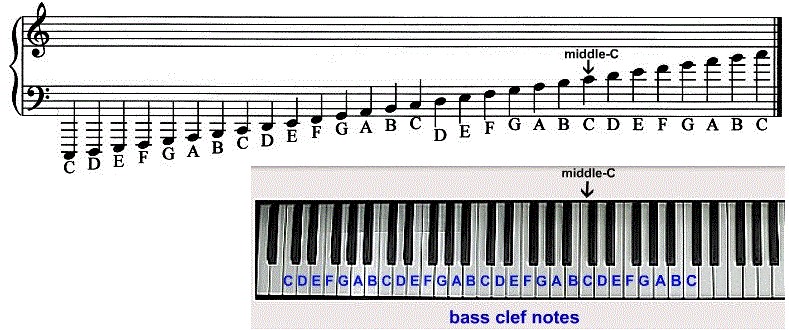
The Bass Clef is also known as the F Clef.
This is because the staff line in between the two dots of this clef is F, any note on this line is the F note.
Notes on the Lines – G B D F A.
Beginning from the bottom, the first line is for G and the fifth line is for A
Notes on the Spaces – A C E G.
Beginning from the bottom, the first space is for A and the fourth space is for G
Tips for Remembering
Is there an easier way of remembering the Bass clef notes?
Yes there is! You can use acronyms to remember the names of the notes on the lines and the spaces.
This is an easier way to remember the bass clef notes.
Notes on the Lines – G B D F A
Remember the sentence "Good Boys Deserve Fudge Always"
Notes on the Spaces – A C E G
Remember the sentence "All Cows Eat Grass"
- [easyazon_link identifier=”0634021427″ locale=”US” tag=”keytarhq04-20″ cart=”n”]The Chord Wheel[/easyazon_link]: The Ultimate Tool for All Musicians, Must guide for learning chords and improvisation
- [easyazon_link identifier=”0876391102″ locale=”US” tag=”keytarhq04-20″ cart=”n”]Berklee Music Theory Book 1[/easyazon_link] (with CD), with excellent hands-on and practical exercises.
- [easyazon_link identifier=”0876391110″ locale=”US” tag=”keytarhq04-20″ cart=”n”]Berklee Music Theory Book 2[/easyazon_link] (with CD), more harmony, chord substitutions, styles and more
- [easyazon_link identifier=”0155026623″ locale=”US” tag=”keytarhq04-20″ cart=”n”]The Music Theory Handbook[/easyazon_link], concise handbook that covers all main topics of music theory
How to Read Music for Better Piano Playing
To be able to read music is an important aspect of learning to play the piano, and it’s not as difficult as it comes across at first glance.
Though many would argue that sight-reading is not a must to be able to play the piano, I would say that there are many advantages to learning it.
Besides, it is not very difficult to understand the basics of written music, with some practice you should be able to do well.
You can also refer to the piano lessons pages on this site for more information.
Here are some suggestions on how to read piano music.
Notes on the Staff
Learn to recognize the notes on the staff. The notes on the lines and the spaces (both treble as well as bass) can be remembered with the help of mnemonics. Learn those mnemonics; it will help you to recognize the notes immediately while playing.
Both clefs together
Learn to see the notes from both the clefs together as you play. Initially you may learn a piece one clef at a time if you find it difficult to play both the clefs together, but it would be a good habit to develop, to be able to play notes from both the clefs together.
Look ahead
You will need to constantly look ahead if you want continuity while playing, this is the secret of how to read music. This is a habit that you will need to develop else you will have to constantly pause till you eyes fall on the next set of notes.
Learn the patterns
Learn the duration of the various types of notes/rests. Learn to recognize the patterns that are formed when tied notes, eighth or sixteenth notes are involved. The patterns will help you to play the correct timings for the notes that are involved.
Slow the tempo
When you start attempting a song, you need not play at the tempo that is specified. Learn the song at a tempo that you are comfortable with and then speed up the tempo.
There are some excellent piano learning software programs that will help you get started on the piano; these include a combination of books, audio, and video lessons which means you can learn piano from the comfort of your own home.
Once you learn to read the notes on the treble/bass, you can learn to read notes for any instrument – its the standard. So if you learn to read sheet music (the treble/bass clef in piano lessons), in theory, you can use those principles to any other instrument.
KeytarHQ editorial team includes musicians who write and review products for pianists, keyboardists, guitarists & other musicians. KeytarHQ is the best online resource for information on keyboards, pianos, synths, keytars, guitars and music gear for musicians of all abilities, ages and interests.



Leave a Reply